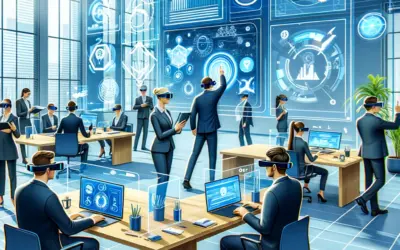1. What is the Metaverse and How Does it Enable Virtual Collaboration?
What is the Metaverse?
The metaverse is often referred to as a virtual reality space where users can interact with a computer-generated environment and other users in real-time. It is a shared digital universe that exists parallel to the real world. In this vast virtual realm, people can immerse themselves in various forms of media, such as virtual reality (VR) games, augmented reality (AR) experiences, and virtual social platforms.
The concept of the metaverse has gained significant attention recently, with technology companies investing heavily in its development. The metaverse aims to combine various emerging technologies, such as VR, AR, 3D graphics, and artificial intelligence. By integrating these technologies, the metaverse can create an interconnected digital world that mirrors our physical reality.
How Does the Metaverse Enable Virtual Collaboration?
One of the key aspects of the metaverse is its potential for virtual collaboration. With the metaverse, users can collaborate and communicate with others regardless of their physical location. This means that individuals can work together on projects, attend virtual meetings, and share information, all without being in the same physical space.
Virtual collaboration in the metaverse is made possible through the use of avatars, which are digital representations of users. These avatars allow individuals to interact and engage with others in a virtual setting, just as they would in the real world. Through voice and video communication, users can hold discussions, brainstorm ideas, and collaborate on projects.
Moreover, the metaverse provides a range of tools and features that enhance virtual collaboration. For example, users can create and share 3D models, prototypes, and designs, allowing for more immersive and interactive collaboration experiences. Additionally, virtual meeting spaces and virtual reality conference rooms enable teams to gather and conduct meetings as if they were physically present.
The Potential of the Metaverse for Business and Education
The metaverse holds immense potential for various industries, including business and education. In the business world, the metaverse can revolutionize remote work by providing a more immersive and interconnected virtual environment. Virtual offices, for instance, can recreate the physical workplace experience, fostering collaboration, and enhancing team dynamics.
In education, the metaverse can transform traditional learning methods. Students can attend virtual classrooms, where they can participate in interactive lessons and engage with their peers and teachers. The metaverse also opens up new possibilities for experiential learning, allowing students to explore historical sites, conduct virtual experiments, and gain practical skills in a simulated environment.
As the metaverse continues to evolve and develop, it will likely become an integral part of our everyday lives. It has the potential to reshape the way we collaborate, learn, and interact with digital content. With its ability to bridge the physical and virtual worlds, the metaverse holds exciting possibilities for the future of technology.
In conclusion, the metaverse is a virtual reality space that enables virtual collaboration. It offers a shared digital universe where users can interact with others in real-time, using avatars and various communication tools. The metaverse has the potential to revolutionize remote work and transform traditional learning methods. As technology continues to advance, the metaverse will likely become an essential part of our daily lives, bringing us closer to a more interconnected and immersive digital world.
2. The Benefits of Virtual Collaboration in the Metaverse
3. Overcoming Challenges in Virtual Collaboration within the Metaverse
3. Overcoming Challenges in Virtual Collaboration within the Metaverse
Collaboration within the metaverse has become an essential aspect of modern virtual experiences. With the increasing popularity of virtual reality (VR) and augmented reality (AR), teams are now able to work together seamlessly, regardless of their physical location. However, this new way of collaborating also presents unique challenges that need to be overcome for effective and efficient virtual teamwork.
One significant challenge in virtual collaboration within the metaverse is the lack of physical presence. Unlike traditional face-to-face meetings, virtual collaboration relies solely on digital platforms and avatars. This absence of physical interaction can result in a loss of non-verbal cues, making it difficult to understand and interpret others’ intentions and emotions. To overcome this challenge, it is crucial to establish clear communication protocols and encourage open and honest dialogue. By emphasizing the importance of active listening and ensuring that everyone has an opportunity to contribute, teams can bridge this gap and foster effective collaboration.
Another obstacle in virtual collaboration is the potential for technological glitches and connectivity issues. As the metaverse relies on stable internet connections and advanced VR/AR technology, any disruptions or malfunctions can hinder collaboration efforts. To mitigate these challenges, it is essential to invest in reliable hardware and software solutions. Regular system updates and maintenance checks can help minimize technical difficulties. Additionally, having alternative communication channels in place, such as instant messaging or phone calls, can ensure that collaboration continues uninterrupted when technical issues arise.
Additionally, cultural and language barriers can pose challenges in virtual collaboration within the metaverse. As teams come from diverse backgrounds and may speak different languages, misunderstandings and miscommunications can occur. It is crucial to establish a shared understanding of cultural differences and promote inclusivity and diversity within the virtual workspace. Providing language support and translation tools can also facilitate effective communication. Encouraging team members to ask questions and seek clarification when needed can go a long way in overcoming language barriers and promoting collaboration.
In conclusion, virtual collaboration within the metaverse offers exciting possibilities for teams to work together regardless of their physical location. However, it is essential to address the challenges that arise in this new way of working. By fostering clear communication, investing in reliable technology, and promoting cultural inclusivity, teams can overcome these challenges and maximize the potential of virtual collaboration. Embracing the metaverse as a platform for collaboration opens up countless opportunities for innovation and creative problem-solving.
4. Best Tools and Platforms for Virtual Collaboration in the Metaverse
4. Best Tools and Platforms for Virtual Collaboration in the Metaverse
In the rapidly evolving digital landscape, virtual collaboration has become a key aspect of work, education, and entertainment. With the rise of the metaverse, a virtual reality space where people can interact and engage with one another, there is a growing need for effective tools and platforms to facilitate virtual collaboration. In this article, we will explore some of the best tools and platforms available for virtual collaboration in the metaverse.
1. VRChat
One of the most popular platforms for virtual collaboration in the metaverse is VRChat. This platform allows users to create and customize their avatars and explore virtual worlds with other users. With its intuitive interface and extensive library of user-created content, VRChat provides a seamless and immersive virtual collaboration experience. Whether you’re attending a virtual conference, hosting a virtual meeting, or simply hanging out with friends in the metaverse, VRChat offers a wide range of features and tools to enhance collaboration and interaction.
2. Spatial.io
Spatial.io is another powerful tool for virtual collaboration in the metaverse. With its advanced spatial computing technology, Spatial.io allows users to collaborate in a shared virtual space, regardless of physical location. Users can upload and manipulate 3D models, share documents, and interact in real-time, making it ideal for remote teams working on complex projects. The platform also offers features like voice chat, virtual whiteboards, and video conferencing, enabling seamless communication and collaboration in a virtual environment.
3. Mozilla Hubs
For those looking for a more open-source and customizable solution, Mozilla Hubs is an excellent choice. With its intuitive web-based interface, users can quickly create virtual spaces and invite others to collaborate. From hosting virtual events to conducting team meetings, Mozilla Hubs offers a versatile platform for virtual collaboration. The platform supports a wide range of media, including 3D models, images, videos, and more, making it ideal for creative collaborations or immersive presentations. With its emphasis on privacy and security, Mozilla Hubs ensures a safe and secure virtual collaboration experience.
In conclusion, the metaverse offers exciting possibilities for virtual collaboration, and having the right tools and platforms can greatly enhance the experience. VRChat, Spatial.io, and Mozilla Hubs are just a few examples of the best tools and platforms available for virtual collaboration in the metaverse. As the metaverse continues to evolve, it’s essential to stay updated with the latest technologies and platforms to make the most of virtual collaboration in this immersive virtual reality space. So, whether you’re a business professional, a student, or a creative enthusiast, consider exploring these tools and platforms to embrace the limitless potential of virtual collaboration in the metaverse.
5. Strategies for Successful Virtual Collaboration in the Metaverse
Virtual collaboration has become increasingly popular in recent years, with the rise of the metaverse providing new opportunities for individuals and businesses to connect and work together in a virtual environment. However, navigating this new digital landscape can be challenging, requiring the implementation of effective strategies to ensure successful collaboration. In this article, we will explore five key strategies to optimize your virtual collaboration in the metaverse.
1. Choose the Right Platform
When it comes to virtual collaboration in the metaverse, choosing the right platform is essential. There are a plethora of options available, each offering different features and capabilities. It’s important to select a platform that aligns with your specific needs and objectives. Consider factors such as ease of use, security features, compatibility with other tools, and the ability to customize your virtual environment. This will ensure that your team has the necessary tools and resources to collaborate effectively.
2. Establish Clear Communication Guidelines
Clear communication is crucial for successful virtual collaboration in the metaverse. Establishing guidelines and expectations from the outset will help ensure that all team members are on the same page. Determine preferred methods of communication, such as video calls, instant messaging, or virtual meetings, and set guidelines for response times and availability. Emphasize the importance of active listening and encourage open and transparent communication to foster a positive collaborative environment.
3. Promote Collaboration and Inclusivity
In the virtual metaverse, it’s essential to foster collaboration and inclusivity among team members. Encourage active participation, brainstorming sessions, and the sharing of ideas. Consider utilizing virtual whiteboards or collaborative tools that allow multiple users to contribute simultaneously. Foster a sense of inclusivity by ensuring that everyone has the opportunity to contribute and be heard. Recognize and value diverse perspectives, as they can lead to innovative and creative solutions.
4. Set Realistic Goals and Deadlines
To ensure effective virtual collaboration in the metaverse, it’s important to set realistic goals and deadlines. Clearly define project objectives and break them down into smaller, achievable tasks. This will help keep everyone on track and provide a sense of progress and accomplishment. Assign responsibilities and establish deadlines to ensure that tasks are completed in a timely manner. Regularly evaluate and adjust goals and deadlines as needed to adapt to changing circumstances.
By implementing these strategies, you can enhance your virtual collaboration in the metaverse, leading to improved productivity, creativity, and teamwork. Remember to choose the right platform, establish clear communication guidelines, promote collaboration and inclusivity, and set realistic goals and deadlines. Embrace the potential of the metaverse and leverage its capabilities to unlock new possibilities for virtual collaboration.
6. Ethical Considerations in Virtual Collaboration within the Metaverse
The Rise of the Metaverse
With the rapid advancements in technology, the concept of the metaverse is no longer confined to the realm of science fiction. The metaverse refers to an interconnected virtual reality where individuals can interact, socialize, and collaborate in a digital environment. As this virtual world becomes more accessible and integrated into our daily lives, it is crucial to consider the ethical implications of virtual collaboration within this metaverse.
Data Privacy and Security
One of the primary ethical concerns associated with virtual collaboration in the metaverse is the issue of data privacy and security. As users navigate the digital landscape, they leave behind a trail of personal data. This data can range from basic identifying information to sensitive details about one’s preferences and behaviors. It is imperative for metaverse platforms to implement robust security measures to safeguard this information and protect the privacy of users.
Furthermore, transparency regarding data collection and usage should be a top priority. Metaverse platforms must provide clear and concise information about the types of data being collected and how it will be used. Users should have the ability to opt-out of data collection if they so choose. By prioritizing data privacy and security, virtual collaboration within the metaverse can be conducted in an ethically responsible manner.
Inclusive Design and Accessibility
As virtual collaboration within the metaverse becomes more prevalent, ensuring inclusive design and accessibility for all users is paramount. It is important to consider individuals with disabilities or those who may face barriers in accessing and navigating the metaverse. Platforms must prioritize accessibility features such as adjustable font sizes, screen reader compatibility, and color contrast options. Moreover, collaboration tools within the metaverse should be designed in a way that allows for seamless interaction and participation among users with diverse abilities and backgrounds.
Promoting diversity and inclusion within the metaverse is not only an ethical imperative but also a business advantage. By prioritizing inclusive design, metaverse platforms can attract a wider user base and foster a more vibrant and diverse virtual community.
Moderation and Digital Citizenship
Another critical ethical consideration within the metaverse is the need for effective moderation and fostering digital citizenship. Virtual collaboration can lead to instances of cyberbullying, harassment, or misinformation spreading unchecked. Metaverse platforms must implement clear guidelines and policies to address these issues and ensure a safe and respectful virtual environment.
Encouraging digital citizenship is equally important. Users should be educated on responsible online behavior and the consequences of their actions within the metaverse. By promoting ethical conduct and providing users with the tools and resources to report and address potential issues, virtual collaboration within the metaverse can thrive in a supportive and constructive manner.
In conclusion, as virtual collaboration within the metaverse becomes more prevalent, it is essential to address the ethical considerations associated with this digital realm. Protecting data privacy and security, prioritizing inclusive design and accessibility, and promoting effective moderation and digital citizenship are crucial for fostering a responsible and ethical virtual environment. By developing and implementing ethical guidelines, metaverse platforms can shape the future of virtual collaboration in a positive and inclusive way.
7. Future Trends in Virtual Collaboration: What to Expect in the Metaverse
Future Trends in Virtual Collaboration: What to Expect in the Metaverse
The concept of virtual collaboration has evolved significantly in recent years, with advancements in technology paving the way for exciting developments in the virtual space. As we move into the future, the metaverse is expected to play a crucial role in virtual collaboration, shaping how we work, interact, and collaborate with others. Here, we explore some of the key trends that we can expect to see in virtual collaboration within the metaverse.
1. Immersive Virtual Reality Experiences:
One of the most significant trends in virtual collaboration within the metaverse is the rise of immersive virtual reality experiences. With the help of VR headsets and advanced haptic technology, individuals will be able to enter a virtual environment that mimics the real world, allowing for seamless collaboration with others. This technology will transform the way teams interact, making remote work feel more like working in the same physical space.
2. Spatial Audio and 3D Soundscapes:
Another key trend that we can expect to see in the metaverse is the integration of spatial audio and 3D soundscapes. Traditional video calls often lack the spatial cues and sense of presence that comes with real-life conversations. However, the metaverse will incorporate advanced audio technologies to create a more immersive and natural communication experience. This will enable participants to better understand each other, leading to improved collaboration and productivity.
3. Customizable Avatars and Digital Identities:
In the metaverse, individuals will have the ability to create customizable avatars and digital identities that represent them in the virtual space. These avatars will not only resemble the individuals in appearance but will also mimic their movements, gestures, and expressions. This level of personalization will enhance collaboration by enabling participants to have a more authentic presence, fostering a sense of connection and trust.
As more organizations embrace virtual collaboration within the metaverse, we can expect these trends to redefine the way we work and collaborate. The advancements in immersive VR experiences, spatial audio, and customizable avatars will revolutionize remote collaboration, blurring the lines between physical and virtual spaces.
It is important for businesses and professionals to stay informed and adapt to these future trends to leverage the full potential of virtual collaboration within the metaverse. By embracing these technologies and incorporating them into their workflows, organizations can foster enhanced communication, increased productivity, and improved collaboration among team members spread across different geographical locations.













0 comentarios